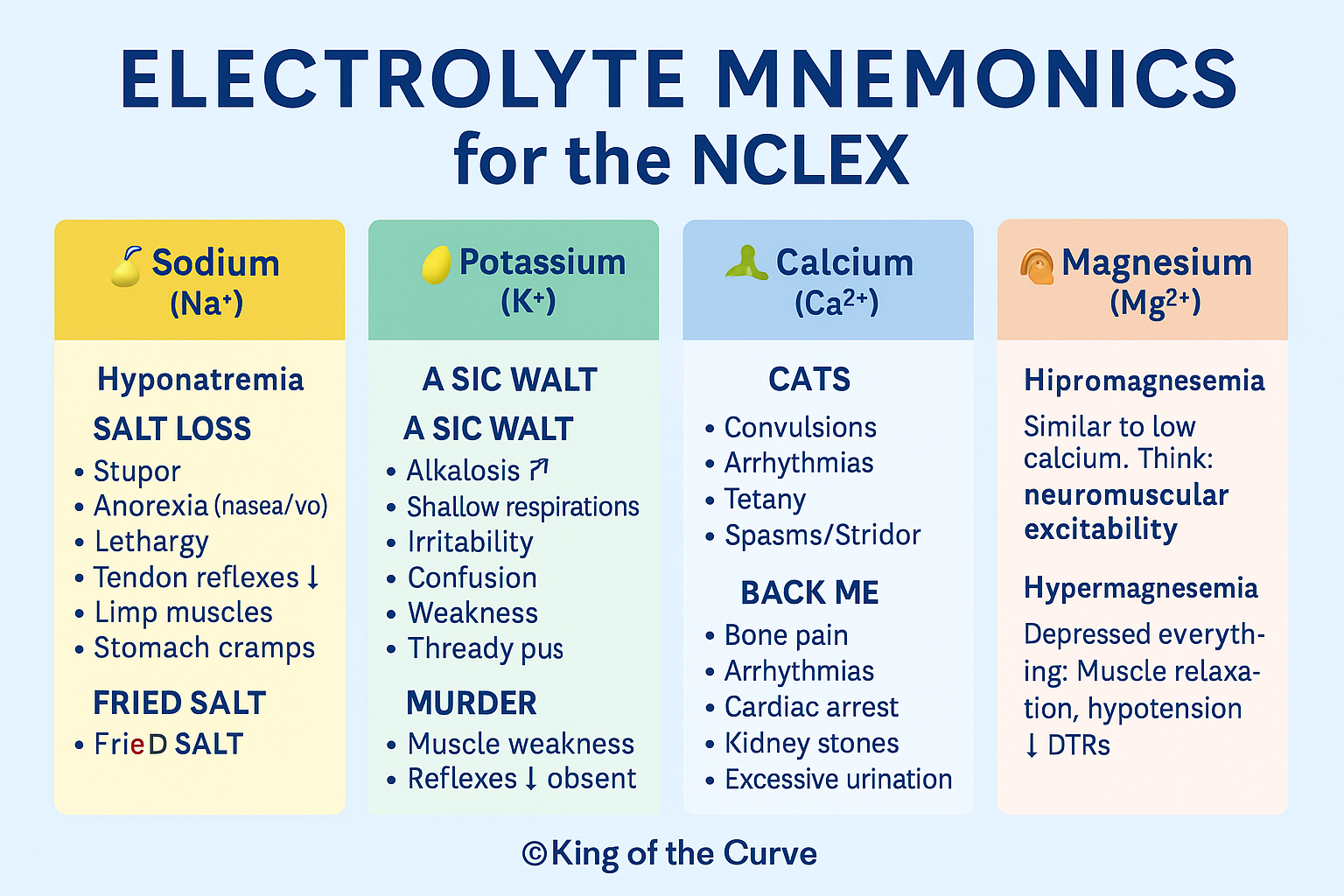🧠 NCLEX Electrolyte Mnemonics: Easy Ways to Remember Sodium, Potassium, Calcium & More
Electrolyte imbalances show up everywhere on the NCLEX—lab value questions, medication safety, prioritization, and patient safety. But memorizing all those symptoms and levels?
✅ That’s where mnemonics come in.
This blog will help you:
Memorize the most tested electrolyte symptoms
Distinguish between hypo- and hyper- states
Apply nursing actions based on KOTC visual mnemonics
Practice with NCLEX-style question formats
🧠 Mnemonics to Remember Electrolyte Imbalances
🧂 Sodium (Na⁺)
Hyponatremia
🧠 "SALT LOSS"
S – Stupor
A – Anorexia (nausea/vomiting)
L – Lethargy
T – Tendon reflexes ↓
L – Limp muscles
O – Orthostatic hypotension
S – Seizures
S – Stomach cramps
🔁 Replace sodium slowly. Monitor neuro status.
Hypernatremia
💥 "FRIED SALT"
F – Flushed skin
R – Restless
I – Increased BP
E – Edema
D – Decreased urine output
S – Skin dry
A – Agitation
L – Low-grade fever
T – Thirst
🍌 Potassium (K⁺)
Hypokalemia
⚡ "A SIC WALT"
A – Alkalosis
S – Shallow respirations
I – Irritability
C – Confusion
W – Weakness
A – Arrhythmias
L – Lethargy
T – Thready pulse
🔁 Administer K⁺ with food. Monitor ECG.
Hyperkalemia
🔥 "MURDER"
M – Muscle weakness
U – Urine (oliguria/anuria)
R – Respiratory distress
D – Decreased cardiac contractility
E – ECG changes (tall T waves)
R – Reflexes ↓ or absent
🔁 Give insulin + D50, calcium gluconate, or kayexalate.
🦴 Calcium (Ca²⁺)
Hypocalcemia
💡 "CATS"
C – Convulsions
A – Arrhythmias
T – Tetany
S – Spasms/Stridor
✅ Positive Chvostek’s & Trousseau’s signs.
Hypercalcemia
🐄 "BACK ME"
B – Bone pain
A – Arrhythmias
C – Cardiac arrest
K – Kidney stones
M – Muscle weakness
E – Excessive urination
🔁 Encourage fluids, loop diuretics, calcitonin.
🧘 Magnesium (Mg²⁺)
Hypomagnesemia
📉 Similar to low calcium. Think: neuromuscular excitability.
Hypermagnesemia
😴 Depressed everything. Think: muscle relaxation, hypotension, ↓ DTRs.
📝 NCLEX-Style Practice Question
A client with a serum potassium of 2.8 is admitted. What should the nurse do first?
A. Restrict fluids
B. Apply seizure precautions
C. Place on cardiac monitor ✅
D. Encourage ambulation
Rationale: Hypokalemia = risk for life-threatening arrhythmias → monitor ECG.
🧠 KOTC Study Tips
🎨 Study visuals daily—electrolyte mnemonics are included in our visual library
📊 Practice NCLEX-style questions in lab value mode
🎮 Use multiplayer and flashcard tools to make it stick
💡 Focus on symptoms + interventions—not just the numbers
Explore these tools at kingofthecurve.org/studyscience
🚀 Call to Action
✅ Start your electrolyte challenge mode → kingofthecurve.org/trial-sessions
✅ Get free lifetime access → kingofthecurve.org/free-lifetime
✅ Play the daily QOTD → kingofthecurve.org/qotd
Frequently Asked Questions (FAQs)
-
Aim for 4-6 focused hours, ensuring you incorporate breaks to avoid burnout.
-
Practice mindfulness techniques, take practice exams under realistic conditions, and maintain a balanced lifestyle.
-
Set short-term goals, seek support from mentors, and reward yourself for small achievements.
-
Regular exercise improves focus, reduces stress, and enhances overall mental clarity.
-
KOTC offers personalized learning tools, gamification features, and adaptive question banks to help students stay on track without burnout.


